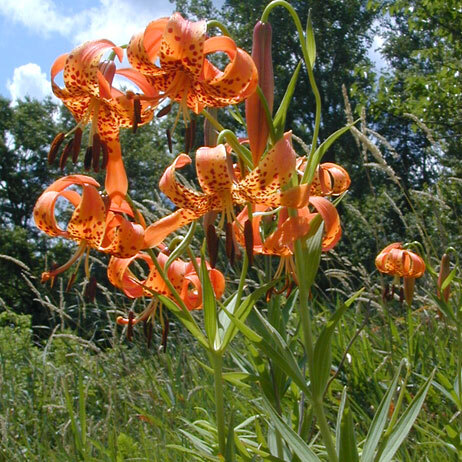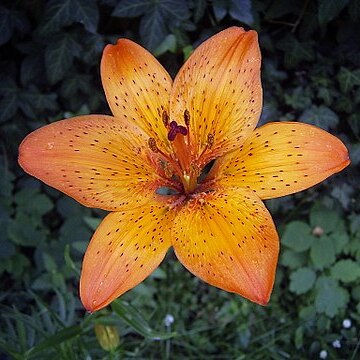Herbs, perennial, bulbose. Bulbs whitish, rarely yellowish or purplish, often stained brown, erect and ovoid (hereafter “ovoid”), irregular and chunky (“chunky”), slanted in ground and ± elongate (“subrhizomatous”), or horizontally elongate (“rhizomatous”), sometimes branching if rhizomatous, rarely if not, 1.4–11.7 × 1.3–19 cm, 0.1–3 times taller than long, annual growth usually obscure; scales (modified leaves) numerous, fleshy and starchy, usually densely covering rhizomes, rarely bearing leaf blades known as basal leaves or their abscission scars, often notched or segmented, longest 0.8–11.9 cm; roots on each bulb either contractile and concentrically wrinkled and thick (to 5 mm), or for nutrition and thinner, fibrous. Stems erect, green, sometimes purple, rarely glaucous, to 3.1 m, ± glabrous, often with adventitious stem roots above bulb. Buds usually rounded in cross section, sometimes ± triangular. Leaves numerous, usually ± evenly distributed along stem, rarely concentrated proximally, scattered or more commonly in 1–12(–24) whorls with some scattered at stem base and apex, 3–20(–40) leaves per whorl, sessile, drooping at tips to ascending, 1.7–29 × 0.2–5.6 cm, 1.6–34 times longer than wide; blade green and somewhat lighter abaxially, rarely paler, linear, lanceolate, elliptic, or obovate, sometimes oblanceolate, especially in proximal leaves, often somewhat lanceolate in distal leaves, margins entire, undulate or not, usually glabrous and smooth or occasionally slightly papillose, sometimes roughened abaxially by ± deltoid epidermal spicules, apex acute to obtuse or rarely acuminate; principal veins usually 3, usually glabrous and smooth abaxially, sometimes with ± deltoid epidermal spicules, rarely impressed adaxially. Inflorescences maturing acropetally, terminal, racemose or umbellate (in small plants), usually open, bracteate, 1–25 (–45)-flowered; bracts usually 1–2 per flower, often with one lanceolate and very wide and the other linear or filiferous. Flowers pendent, nodding, horizontal, ascending, or erect, radially or slightly bilaterally symmetric, fragrant or not; perianth campanulate, funnelform, or with sepals and petals strongly reflexed in form of a “Turk’s-cap”; sepals and petals usually differentiated, sometimes indistinctly so, recurved or reflexed, distinct, orange, red, yellow, pink, or white, usually with adaxial magenta or maroon spots concentrated in proximal 1/2–2/3, ± lanceolate and narrowed or rarely clawed, glabrous (pubescent strip at base in L. lancifolium), nectaries present on each but often more developed on sepals, basal, green, usually hidden but occasionally exposed and forming visible green star at adaxial base of perianth; sepals 3, occasionally ridged abaxially, 3.1–12 × 0.6–2.6 cm, apex usually acute; petals 3, ridged abaxially, with 2 adaxial longitudinal median rounded ridges, 3–11.2 × 0.6–3.4 cm, apex usually acute, often more widely than sepal apex; stamens 6, opposite sepals and petals, distinct, included to strongly exserted; filaments ± parallel to style or spreading, diverging to 31° from flower axis, color variable but usually pale green or nearly translucent; anthers versatile, color variable, usually purplish, becoming darker, oblong, 0.3–2.6 cm; pollen cream, yellow, peach, tan, orange, rust, or brown, usually becoming lighter; pistil compound, 3-lobed, 3-locular, oblong, 2.1–10.5 cm; ovary superior, 0.8–3.5 cm, axile placentas 6, ovules as many as seeds, a few developing without embryos; style initially parallel to flower axis, usually elongating and curving toward periphery, usually pale green, round in cross section; stigma 3-lobed, hollow in older flowers; pedicel not articulate, 0.8–32 cm. Fruits erect, green maturing to brown, capsular, 3-valved, not strongly winged, ± oblong-obovate, 1.5–7.7 × 0.8–3.3 cm, 1.1–4.8 times longer than wide, base constricted, dehiscence loculicidal. Seeds 67–330, light brown with darker ovate embryo in center, 6-ranked, flat
More
Erect, usually glabrous herbs. Bulb scaly; roots thick, produced from below the bulb and in some species from the base of the aerial stem. Aerial stem annual, erect, usually unbranched. Leaves cauline, alternate or verticillate, linear or broadly flattened, usually sessile, sometimes with bulbils in their axils. Flowers solitary and terminal, or in a racemose inflorescence of solitary flowers in the axils of the often leaf-like bracts. Pedicels erect to cernuous, not articulated. Perianth segments free, ± equal, infundibuliform or campanulate, sometimes clawed, sometimes adhering and forming a tube, spreading or recurving distally, with a nectariferous longitudinal furrow towards the base. Filaments filiform or subulate, attached to the receptacle or to the base of the segments; anthers dorsifixed, linear, introrse, versatile. Ovary superior, sessile, oblong to obovoid, 3-celled; ovules axile, ∞; style terete sometimes clavate, 3-lobed. Capsule coriaceous, loculicidal, perianth deciduous. Seeds flat.
Herbs perennial, bulbiferous. Bulb of many imbricate, fleshy scales, without tunic. Stem erect, leafy. Leaves alternate, rarely whorled, sessile or subsessile, usually linear to linear-lanceolate. Bulblets sometimes present in leaf axils. Inflorescence terminal, a raceme or solitary flower, very rarely an umbel or corymb; bracts leaflike. Flowers often funnelform or campanulate, sometimes tubular or cupular. Tepals 6, free, usually connivent, sometimes strongly recurved or revolute, white, yellow, greenish, or reddish to purplish, nectariferous near base adaxially; nectaries usually narrowly grooved, sometimes fringed with papillae or hairs, rarely flat on outer tepals. Stamens 6; filaments subulate or filiform, sometimes pubescent; anthers dorsifixed, versatile. Ovary 3-loculed; ovules many per locule. Style elongate, slender; stigma swollen, usually 3-lobed. Fruit a loculicidal capsule. Seeds many, arranged like a pile of coins in each valve, flat, narrowly winged all round.
Herbs perennating from bulbs with numerous imbricate fleshy scales; above-ground parts annual. Roots fibrous. Stem unbranched, erect or ascending. Leaves numerous, alternate, opposite, or sometimes almost verticillate, sessile; axillary bulbils sometimes produced. Inflorescence terminal, racemose, spicate, subumbellate or flower solitary. Flowers bisexual, actinomorphic, usually large, often funnel-shaped, white or brightly coloured, subtended by leaflike bracts. Perianth segments 6, free, nectariferous at base. Stamens 6; anthers versatile, dehiscing by slits, introrse. Ovary superior, cylindrical; locules 3; style 1, elongate; stigma capitate, 3-lobed or 3-fid; ovules numerous; placentation axile. Fruit a loculicidal capsule. Seeds numerous, winged.
Perianth campanulate or funnelform, its 6 tep clawed or sessile, erect to spreading or recurved, often connivent at base, in our spp. spotted with purple toward the base; stamens 6; filaments elongate, often divergent from the style; anthers linear, versatile; style elongate, with 3-lobed stigma; fr a loculicidal capsule with numerous closely packed, flat seeds; tall perennial herbs from a scaly bulb, our spp. with an erect stem bearing numerous narrow lvs (alternate or whorled) and at the summit 1–many erect or nodding, yellow to red fls. 80, N. Temp.
Perennials; bulb scaly. Stem simple, glabrous or pubescent. Leaves all cauline, upper sometimes with bulbils in axils, linear or lanceolate, usually sessile, scattered or verticillate. Flowers large, trumpet-like, solitary, or in lax terminal racemes; segments free, varying in shape, spreading or revolute in upper half, usually with basal nectary. Capsule obovate, 6-ribbed. Seeds many, flat. Spp. c, 80, of N. Temperate regions. Adventive spp. 2.


